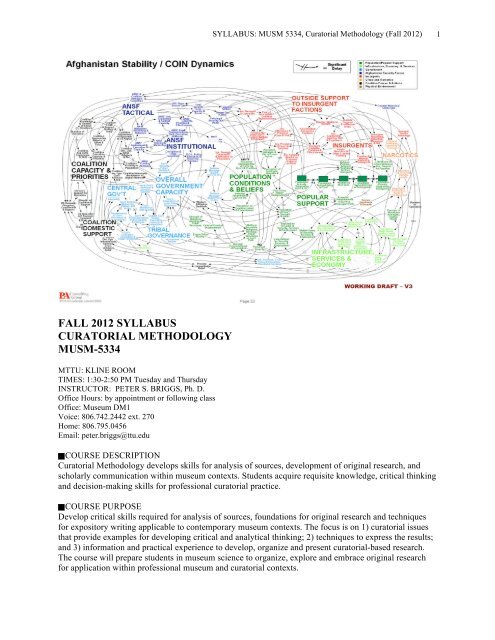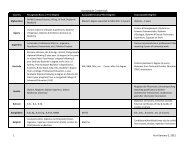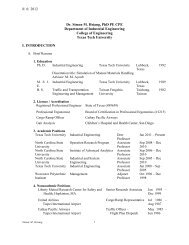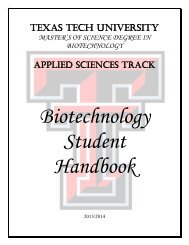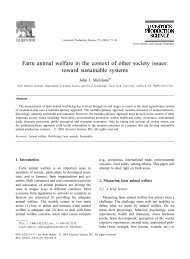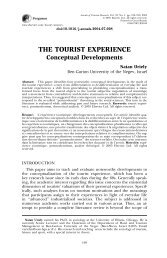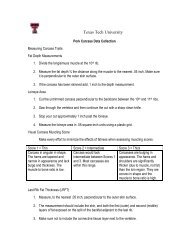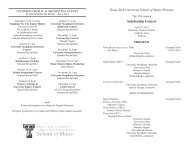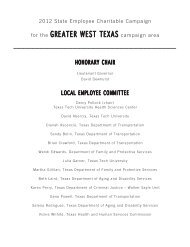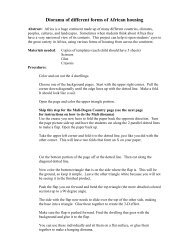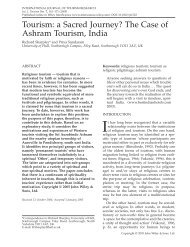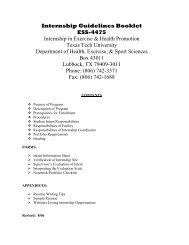SYLLABUS 2012 - Texas Tech University
SYLLABUS 2012 - Texas Tech University
SYLLABUS 2012 - Texas Tech University
Create successful ePaper yourself
Turn your PDF publications into a flip-book with our unique Google optimized e-Paper software.
<strong>SYLLABUS</strong>: MUSM 5334, Curatorial Methodology (Fall <strong>2012</strong>) 1<br />
FALL <strong>2012</strong> <strong>SYLLABUS</strong><br />
CURATORIAL METHODOLOGY<br />
MUSM-5334<br />
MTTU: KLINE ROOM<br />
TIMES: 1:30-2:50 PM Tuesday and Thursday<br />
INSTRUCTOR: PETER S. BRIGGS, Ph. D.<br />
Office Hours: by appointment or following class<br />
Office: Museum DM1<br />
Voice: 806.742.2442 ext. 270<br />
Home: 806.795.0456<br />
Email: peter.briggs@ttu.edu<br />
COURSE DESCRIPTION<br />
Curatorial Methodology develops skills for analysis of sources, development of original research, and<br />
scholarly communication within museum contexts. Students acquire requisite knowledge, critical thinking<br />
and decision-making skills for professional curatorial practice.<br />
COURSE PURPOSE<br />
Develop critical skills required for analysis of sources, foundations for original research and techniques<br />
for expository writing applicable to contemporary museum contexts. The focus is on 1) curatorial issues<br />
that provide examples for developing critical and analytical thinking; 2) techniques to express the results;<br />
and 3) information and practical experience to develop, organize and present curatorial-based research.<br />
The course will prepare students in museum science to organize, explore and embrace original research<br />
for application within professional museum and curatorial contexts.
<strong>SYLLABUS</strong>: MUSM 5334, Curatorial Methodology (Fall <strong>2012</strong>) 2<br />
REQUIRED READINGS<br />
• Akrich, Madeleine. 1992. “The de-scription of technical objects.” In Shaping technology, ed.<br />
Weibe Bijker and John Law, 205-224. Cambridge: MIT Press.<br />
• Appadurai, Arjun. 1994. “Commodities and the politics of value.” In Interpreting objects and<br />
collections, ed. Susan M. Pearce, 76-91. London: Routledge.<br />
• Binford, Lewis R. 1962. “Archaeology as anthropology.” American Antiquity 28(2): 217-225.<br />
• Borges, Jorge Luis. 1998. Collected fictions, translated by Andrew Hurley, 112-118. New York:<br />
Penguin Putnam.<br />
• Bowker, Geoffrey C. and Susan Leigh Star. 1999. Sorting things out: classification and its<br />
consequences, 285-365. Cambridge: MIT Press, Cambridge.<br />
• Brown, Michael F. 1998. “Can Culture be Copyrighted?” Current Anthropology 39(2): 193-222.<br />
• Clarke, David. 1994. “Culture as a system with subsystems.” Interpreting objects and collections,<br />
ed. Susan M. Pearce, 44-47. London: Routledge.<br />
• Clouse, Abby. 2008. “Narratives of value and the ‘Antiques Roadshow’: ‘Game of<br />
Recognitions.’” Journal of Popular Culture 41(1): 3-20.<br />
• Crew, Spencer R. and James E. Sims. 1991. “Locating authenticity: fragments of a dialogue.”<br />
Exhibiting Cultures: The Poetics and Politics of Museum Display, ed. Ivan Karp and Steven D.<br />
Lavine, 159-175. Washington: Smithsonian Institution Press.<br />
• Cuno, James. “Museums, Antiquities, Cultural Property, and the US Legal Framework for<br />
Making Acquisitions.” In Who owns the past? ed. Kate Fitz Gibbon, 143-157. Brunswick, New<br />
Jersey: Rutgers <strong>University</strong> Press.<br />
• Deetz, James F. Deetz and Edwin S. Dethlefsen. 1966. “Death’s head, cherubs, and willow trees:<br />
experimental archaeology in Colonial Cemeteries.” American Antiquity 31(4): 502-510.<br />
• Gibbon, Kate Fitz. “The Elgin Marbles.” In Who owns the past? ed. Kate Fitz Gibbon, 109-121.<br />
Brunswick, New Jersey: Rutgers <strong>University</strong> Press.<br />
• Hedstrom, Margaret and John Leslie King. 2005. Epistemic infrastructure in the rise of the<br />
knowledge economy, 1-19. No publisher.<br />
• Kirshenblatt-Gimblett, Barbara. 1991. “Objects of Ethnography.” In Exhibiting cultures: the<br />
poetics and politics of museum display, ed. Ivan Karp and Steven D. Lavine, 386-443.<br />
Washington: Smithsonian Institution Press.<br />
• 1 Latour, Bruno. 1992. “Where are the missing masses? The sociology of a few mundane<br />
artifacts.” Shaping technology, ed Weibe Bijker and John Law, 225-258. Cambridge: The MIT<br />
Press.<br />
• 2 Latour, Bruno. 2011. “Some Experiments in Art and Politics.” In e-flux, http://eflux.com/journal/view/217<br />
• Latour, Bruno and Adam Lowe. In press. “The migration of the aura or how to explore the<br />
original through its facsimiles.” In Switching Codes, ed. Thomas Bartscherer, np. Chicago:<br />
<strong>University</strong> of Chicago Press.<br />
• Levi-Strauss, Claude. 1961 (English edition; 1955 original French edition). Tristes Tropiques,<br />
translated by John Russell, 160-180. New York: Criterion Books.<br />
• Meltzer, David J. 1981. “Ideology and culture.” In Modern material culture: the archaeology of<br />
us, ed. Richard A. Gould and Michael B. Schiffer, 113-125. New York: Academic Press.<br />
• Morris, Errol. September 25, 2007, 6:48 pm. “Which Came First, the Chicken or the Egg? (Part<br />
One)”; October 4, 2007, 11:21 pm. “Which Came First? (Part Two)”; October 23, 2007, 11:42<br />
pm. “Which Came First (Part Three): Can George Lionel and Marmaduke Help Us Order the<br />
Fenton Photographs”.<br />
o http://opinionator.blogs.nytimes.com/2007/09/25/which-came-first-the-chicken-or-theegg-part-one/<br />
o http://opinionator.blogs.nytimes.com/2007/10/04/which-came-first-part-two/
<strong>SYLLABUS</strong>: MUSM 5334, Curatorial Methodology (Fall <strong>2012</strong>) 3<br />
o http://opinionator.blogs.nytimes.com/2007/10/23/which-came-first-part-three-cangeorge-lionel-andmarmaduke-help-us-order-the-fenton-photographs/<br />
• Preda, Alex. 1999. “The turn to things: arguments for a sociological theory of things.” The<br />
Sociological Quarterly 40(2): 347-366.<br />
• Rothschild, Nana A. 1981. “Pennies from from Denver.” In Modern material culture:<br />
the archaeology of us, ed. Richard A. Gould and Michael B. Schiffer, 161-181. New York:<br />
Academic Press.<br />
• White, Hayden. 2004. “The fictions of factual representation.” In Grasping the world: the idea of<br />
the museum, ed. Donald Preziosi and Claire Farago, 22-35. Burlington, VT: Ashgate Publishing.<br />
USEFUL TEXTS (IN MOTTU LIBRARY)<br />
• Berkman, R.I. 2000. Find it fast: how to uncover expert information on any subject online or in<br />
print. Fifth edition. New York: Harper Resource.<br />
• Booth, Wayne C., Joseph R. Williams, and Gregory G. Colomb. 2003. The craft of research. 2nd<br />
edition. Chicago: <strong>University</strong> of Chicago Press.<br />
• Buch, Rebecca A and Jean Allman Gilmore eds. 2010. MRM5: Museum Registration Methods,<br />
5th Edition. Washington: American Association of Museums Press.<br />
• Hacker, Diane. 2003. A writer’s reference. Fifth edition. Boston: Bedford/St. Martins.<br />
• Harvey, Gordon. 1998. Writing with sources: a guide for students. Indianapolis: Hackett<br />
Publishing Co., Inc.<br />
• Lunsford, Andrea A. 2008. The St. Martin’s handbook, 6th edition. Boston: Bedford/St. Martin’s.<br />
• Serrell, Beverly. 1996. Exhibit labels: an interpretive approach. Walnut Creek: Alta Mira Press.<br />
• Strunk, W. and E.B. White. 2003. The elements of style. Fourth edition. Needham, MA: Allyn &<br />
Bacon.<br />
• Thompson, John M.A., et al. 1992. Manual of curatorship: a guide to museum practice. 2nd<br />
edition. Oxford: Butterworth-Heinemann, Ltd.<br />
• <strong>University</strong> of Chicago Press. 2003. The Chicago Manual of Style. 15 ed. Chicago: <strong>University</strong> of<br />
Chicago Press.<br />
SELECT INTERNET TEXTS (not in any specific order)<br />
• Hacker, Diana. Research and documentation online.<br />
http://www.dianahacker.com/resdoc/<br />
• Zalta, Edward N., editor. Stanford Encyclopedia of Philosophy.<br />
http://plato.stanford.edu/<br />
• Harvard <strong>University</strong>. The Writing Center.<br />
http://www.fas.harvard.edu/~wricntr/resources.html<br />
• wordorigins.org<br />
http://www.wordorigins.org/<br />
• bartleby.com [Great Books online]<br />
http://bartleby.com/<br />
• Oxford English Dictionary Online [go through TTU <strong>University</strong> Library since they have a<br />
subscription]<br />
http://dictionary.oed.com/entrance.dtl<br />
• The <strong>University</strong> Writing Center, <strong>Texas</strong> <strong>Tech</strong> <strong>University</strong><br />
http://uwc.ttu.edu/default.asp<br />
http://english.ttu.edu/uwc01/Resources/default.asp<br />
[reference materials online at Writing Center]<br />
• The OWL at Purdue<br />
http://owl.english.purdue.edu/owl/
<strong>SYLLABUS</strong>: MUSM 5334, Curatorial Methodology (Fall <strong>2012</strong>) 4<br />
• Duke <strong>University</strong> Libraries: Citing Sources<br />
http://library.duke.edu/research/citing/<br />
• Museology Bibliography (BMUSE)<br />
http://daryl.chin.gc.ca:8000/BASIS/bmus/user/www/sf<br />
• Google translator<br />
http://translate.google.com/<br />
• foreignword.com the language site<br />
http://www.foreignword.com/<br />
FALL 2010 CLASS SCHEDULE AND OUTLINE<br />
General things to remember:<br />
• Instructor’s Email: peter.briggs@ttu.edu<br />
• You must turn in hard copies of all CYH Tasks, Short Papers and the Annotated Bibliography.<br />
Hard copies are due at the end of class on the day noted on the syllabus. All written assignments<br />
must also be sent as an email attachment on or before the dates and times noted on the syllabus<br />
and handouts. Late assignments may not be graded or will be marked down unless prior approval<br />
from the instructor for an extension has been obtained.<br />
GENERAL TOPIC ASSIGNMENTS<br />
Ø Aug 28 TU, Introduction 1<br />
Ø Aug 30 TH, Introduction 2<br />
Ø Sep 4 TU, Critical Review/Discussion, Borges, Clark, Latour 2;<br />
Misc. Assignment1<br />
Ø Sep 6 TH, Critical Review/Discussion, Borges, Clark, Latour 2 continued;<br />
Misc. Assignment2<br />
Short Essay1 due; email due by 9am and submit hard copy at end of class<br />
Ø Sep 10 MO, Curating Your Home: CYH1 due via email by 9am<br />
Ø Sep 11 TU, CYH I bring hard copy to class for discussion and review;<br />
Ø Sep 13 TH discussion about annotated bibliography<br />
Ø Sep 17 MO submit by email clearly written topic for annotated bibliography by 9am<br />
Ø Sep 18 TU, Critical Review/Discussion, Hedstrom and King<br />
Ø Sep 20 TH, Critical Review/Discussion, Bowker and Star; James Cokendolpher???<br />
Ø Sep 24 MO last day to have annotated bibliography topic approved by 4pm<br />
Ø Sep 25 TU, Movie: Freakonomics<br />
Ø Sep 27 TH, Critical Review/Discussion, Binford;<br />
Short Essay2 due, email by 9am, submit hard copy at end of class; Misc. Assignment3
<strong>SYLLABUS</strong>: MUSM 5334, Curatorial Methodology (Fall <strong>2012</strong>) 5<br />
Ø Oct 1 MO, Curating Your Home: CYH2 email due by 9 am<br />
Ø Oct 2 TU, Curating Your Home: CYH2 discussion<br />
Ø Oct 4 TH, Movie: Power Trip<br />
Ø Oct 9 TU, Meet at The Ranching Heritage Center, presentation by Dr. Scott White<br />
Ø Oct 11 TH, Critical Review/Discussion, Akrich;<br />
Short Essay3 due, email by 9 am, submit hard copy at end of class; Misc. Assignment4<br />
Ø Oct 16 TU, Critical Review/Discussion: Meltzer, Crew and Sims<br />
Ø Oct 18 TH, Critical Review/Discussion: Preda<br />
Ø Oct 22 MO by email send at least five annotations from bibliography by 9 am<br />
Ø Oct 23 TU, Annotated Bibliography: bring for review at least five annotations; turn in hard copy<br />
at end of class<br />
Ø Oct 25 TH, Critical Review/Discussion, Latour and Lowe; Kirshenblatt-Gimblett<br />
Misc. Assignment 5<br />
Ø Oct 30 TU, Critical Review/Discussion, Kirshenblatt-Gimblett continued<br />
Short Essay4 due, email by 9 am, submit hard copy at end of class; meet in MoTTU Ethnohistory<br />
Gallery<br />
Ø Nov 1 TH, Critical Review/Discussion, Latour1<br />
Ø Nov 6 TU, Critical Review/Discussion, Morris (all)<br />
Misc. Assingment6<br />
Ø Nov 8 TH, Critical Review/Discussion, White<br />
Misc. Assignment7<br />
Ø Nov 13 TU, Critical Review/Discussion: Deetz and Dethlefson; Misc. Assignment8<br />
Ø Nov 15 TH, Critical Review/Discussion, Levi-Strauss, Rothschild<br />
Misc. Assingment9<br />
Ø Nov 20 TU, Critical Review/Discussion: Brown, Cuno, Gibbons<br />
Misc. Assignment10; Short essay5 due, email by 9 am, submit hard copy at end of class<br />
Ø Nov 22 TH, no class<br />
Ø Nov 26 MO, Curating Your Home: CYH3 email due by 9am<br />
Ø Nov 27 TU, Curating Your Home: CYH3 discussion<br />
Ø Nov 29 TH, Critical Review/Discussion: Clouse, Appadauri;
<strong>SYLLABUS</strong>: MUSM 5334, Curatorial Methodology (Fall <strong>2012</strong>) 6<br />
Misc. Assignment11<br />
Ø Dec 3 MO, Annotated Bibliography; last day to submit hard copy and email attachment of<br />
annotated bibliography. DEADLINE: 4pm for email and hard copy.<br />
Ø Dec 4 TU, Curating Your Home: CYH3 Power Point Exhibitions1<br />
Ø Dec 5 WE, last day to submit CYH3 power point presentation by 4pm<br />
Ø Dec 6 -12, TBD, Curating Your Home: CYH 3Power Point Exhibitions if needed<br />
EXPECTED LEARNING OUTCOMES<br />
Following completion of this course, students will be able to:<br />
• Analyze scholarly articles and books in museum related literature for coherence and logic of<br />
arguments, relevance of data, reasonableness of conclusions, and significance to the field.<br />
• Identify and develop research topics.<br />
• Plan research programs.<br />
• Convey research findings in relevant formats.<br />
• Identify and critically evaluate published literature.<br />
• Achieve a synthetic understanding of the relationship between research and curation.<br />
• Gain practical expertise in effectively communicating research and critical analyses.<br />
METHODS FOR ASSESSING LEARNING OUTCOMES<br />
The course outcomes will be assessed through response papers, oral presentations, class discussion and<br />
participation, an annotated bibliography, and written curatorial exercises. There are no extra credit<br />
assignments.<br />
1. Class Participation and Presentation<br />
Students are required to: read all assignments and be prepared to discuss, analyze and formulate questions<br />
about the content of the assigned readings present assigned readings and lead discussion. Oral<br />
presentations must focus on the identification of the author’s thesis, a concise and accurate representation<br />
of the author’s argument, the evidence for the argument and the reasonableness of the author’s<br />
conclusion(s). Class participation is an important component of this course. Participation includes<br />
students presenting assigned readings, asking questions, answering questions, and initiating<br />
relevant discussion.<br />
2. Short Essay Papers<br />
Students will submit five written essays. Each paper will:<br />
• identify its topic<br />
• present coherent arguments<br />
• critically evaluate relevant data<br />
• critically evaluate the success or failure of arguments<br />
• offer suggestions for further research or improvement<br />
• provide concluding remarks<br />
• articulate ideas in clear, grammatically correct English<br />
Effective critical remarks, conclusions, and suggestions will not simply be personal opinion. The essays<br />
will demonstrate understanding of a developed point(s) of view and argument(s), and insightfully respond<br />
to them. Your remarks and opinions will be collegial and informed, including explanations of the success<br />
or failure of the argument and reasons for its success or failure.
<strong>SYLLABUS</strong>: MUSM 5334, Curatorial Methodology (Fall <strong>2012</strong>) 7<br />
The purposes of these essays are to:<br />
• develop critical reading skills<br />
• identify successful and problematic arguments<br />
• express critical thinking in a coherent and objective format<br />
• effectively and clearly express complex ideas in written English.<br />
The length of each Short Essay Paper will be five pages of expository text in 11 point Times New Roman<br />
or similar serif typeface. The papers will have one-inch margins on the left, right, top and bottom. Do not<br />
use footnotes. Use text citations and include a list of references cited. The list of references cited is not a<br />
part of the five-page requirement. Place a header outside of the one-inch margins in the upper right corner<br />
of each page. This header must include your first and last name, the class and assignment (e.g., MUSM<br />
5334 Short Essay3), the date, and a page number. It would look something like this:<br />
“Jane Doe, MUSM 5334 Short Essay3, 24 Aug 2011, 1”. This header must appear at the top of every<br />
page and make sure that the page numbers change progressively.<br />
3. Annotated Bibliography<br />
Each student will develop an annotated bibliography on a curatorial topic. The topic selected by the<br />
student must be approved in advance by the instructor. The bibliography will be inclusive, presented in<br />
written format and focus on professional or scholarly publications. The bibliography can be considered<br />
finished if there are more than 35 citations. An annotation is a summary and evaluation of a publication’s<br />
relevance to the topic. An annotated bibliography, therefore, includes bibliographic citations as well as a<br />
summary and evaluation of the cited source. The annotated bibliography will:<br />
• provide an introductory paragraph that identifies clearly the subject of the bibliography;<br />
• summarize the primary argument(s) of each source;<br />
• evaluate the usefulness, relevance, objectivity and reliability of the source.<br />
The purposes of this assignment are to:<br />
• identify potential research topics<br />
• organize materials as a literature review<br />
• read critically<br />
• summarize succinctly and effectively.<br />
A consistent style of citation must conform to one of the following: The Chicago Manual of Style,<br />
American Psychological Association (APA) or Modern Language Association (MLA). The topic of the<br />
annotated bibliography must be approved in advance by the instructor. Text will be in 11 point Times<br />
New Roman type with one-inch margins on the left, right, top and bottom. Use the same header format as<br />
outlined in the Short Essay assignments.<br />
Some observations about the annotated bibliography:<br />
• Search out and find other examples of annotated bibliographies. They might provide ideas on<br />
how to organize your bibliography.<br />
• Your annotations will generally be written in paragraph form, varying from one or two sentences<br />
to a long paragraph. A sentence or two of your summary should be followed by a sentence or two<br />
of evaluation.<br />
• You will need to read the source in order to annotate it. As you gain experience, you might want<br />
to modify your reading techniques.<br />
• For additional information and examples a potentially useful source is:<br />
http://owl.english.purdue.edu/handouts/general/gl_annotatedbib.html
<strong>SYLLABUS</strong>: MUSM 5334, Curatorial Methodology (Fall <strong>2012</strong>) 8<br />
4. Curating Your Home<br />
Each student will curate a group of 7 items selected from their dwelling in Lubbock. There will be three<br />
assignments or tasks associated with curating this collection. There is a separate handout covering the<br />
details of this curation project. Assignments require:<br />
• revisions of information about items in the collection;<br />
• written and oral reasoned justifications for methods and techniques used to revise information<br />
about the items;<br />
• written and oral review of problems associated with revising information on the items<br />
• presentation.<br />
The purposes of this assignment are to<br />
• provide concrete exercises related to curatorial decision-making;<br />
• critically review and examine curatorial decision-making processes;<br />
• use curatorial methods;<br />
• critically review and examine curatorial methods.<br />
The length of each CYH assignment will be determined by the amount of space needed to respond to the<br />
task. Each assignment will be typed and may include images, diagrams, drawings or other relevant<br />
supporting information. The papers will have one-inch margins on the left, right, top and bottom. Do not<br />
use footnotes. Use text citations and include a list of references cited. Place a header outside of the<br />
one-inch margins in the upper right corner of each page. This header must include your first and last name,<br />
the class and assignment (e.g., MUSM 5334 CYH2), the date, and a page number. It would look<br />
something like this: “Jane Doe, MUSM 5334 CYH2, 24 Aug 2011, 1”. This header must appear at the top<br />
of every page and make sure that the page numbers change progressively.<br />
5. Other<br />
Films, special or guest lectures outside of regular class meetings and field trips may be assigned<br />
periodically.<br />
Guidelines for Email attachments and hard copies of papers:<br />
• All written assignments will follow APA, MLA or Chicago Manual styles.<br />
• All digitally submitted assignments will be formatted for 8 ½ x 11 inch paper; have one inch<br />
margins on top, sides and bottom; double spaced; 11 point type in Times New Roman or very<br />
similar type face (no script typefaces); no formatting; indent new paragraphs five spaces; submit<br />
as attachment to an email. Save files as either MSWord .doc, .docx or as .rtf. DO NOT SUBMIT<br />
AS PDF FILES.<br />
Attached email files must be named in the following manner:<br />
• For short essays: last name of student_assignment (e.g., briggs_CYH2.doc)<br />
• All hard copy written assignments will be typed, 1” margins, and stapled in the upper right corner.<br />
No extra lines between paragraphs. The typeface will be 11 point Times New Roman or a very<br />
similar serif type face. No script typefaces are permitted. The student’s name, the course number,<br />
the assignment, the date, and a page number must be included as a header outside of the one inch<br />
margin and in the upper right corner. typed on the first page. Illegible and grammatically<br />
incoherent papers are not acceptable. Paper will be on white paper; type will be black ink. If you<br />
use citations, do not use footnotes. Use either endnotes or citations within the text followed at the<br />
end by a list of “References Cited”. Endnotes or references cited are NOT counted toward the<br />
length of the assignment.
<strong>SYLLABUS</strong>: MUSM 5334, Curatorial Methodology (Fall <strong>2012</strong>) 9<br />
CRITERIA FOR GRADING<br />
Short Essays (5@ 10 pts ea)<br />
Annotated Bibliography<br />
Curating Your Home (3 tasks)<br />
Class Participation<br />
Oral Presentations<br />
Quizzes (5 @ 4 pts ea)<br />
50 pts<br />
35 pts<br />
35 pts<br />
30 pts<br />
30 pts<br />
20 pts<br />
Total 200<br />
Grading follows OP 34.12: A=Excellent (180-200 pts); B=Good (160-179 pts); C=Average (140-159<br />
pts); D=Inferior (120-139 pts); F=Failure (below 120 pts); P=Passing; PR=In Progress; I=Incomplete; and<br />
W=Withdrawal. A plus or a minus may be added to the grade. Please note: the grade of I is given only<br />
when a student’s work is satisfactory in quality but, due to reasons beyond her or his control, has not been<br />
completed. It is not given in lieu of an F or W. Assigned work and a change of grade must be recorded<br />
within one calendar year from the date of the I. Failure to do so results in an F for that course.<br />
FALL 2011 SEMESTER: IMPORTANT UNIVERSITY DATES<br />
Aug 27 Classes begin<br />
Dec 5 Last day of classes<br />
Sep 3 Labor Day<br />
Dec 7-12 Final Exams<br />
Nov 21-25 Thanksgiving<br />
Dec 14-15 Commencement<br />
CLASS POLICIES<br />
• Attendance at every class is required excepting religious holy days or officially sponsored trips.<br />
Any other excused absences are determined by the instructor.<br />
• During class ALL electronic devices will be shut-off or in “airplane mode”. This includes IPODS,<br />
IPADS, lap tops, phones, and similar devices. The only exception will be for presentations.<br />
• Late work will only be accepted if the instructor is presented with an acceptable notice in advance<br />
of a religious holy day or official university trip, or after the fact and within the week of the<br />
student’s return to class with a documented emergency.<br />
• Academic Honesty. (Please see OP 34.12.) It is the aim of the faculty of <strong>Texas</strong> <strong>Tech</strong> <strong>University</strong><br />
to foster a spirit of complete honesty and high standard of integrity. The attempt of students to<br />
present as their own any work not honestly performed is regarded by the faculty and<br />
administration as a most serious offense and renders the offenders liable to serious consequences,<br />
possibly suspension. “Scholastic dishonesty” includes, but it not limited to, cheating, plagiarism,<br />
collusion, falsifying academic records, misrepresenting facts, and any act designed to give unfair<br />
academic advantage to the student (such as, but not limited to, submission of essentially the same<br />
written assignment for two act. Academic standards for written student work require that all ideas<br />
and any phrases longer than five words must be properly acknowledged.<br />
• Health and Safety. MTTU will endeavor to comply with the intent of state laws or acts and the<br />
<strong>University</strong> Health and Safety Program in an effort to maintain a safe academic and working<br />
environment for students, staff, and faculty.<br />
• Observance of Religious Holy Day or Officially Approved Trip. (Please see OP 34.19.) A student<br />
who intends to observe a religious holy day or make an official trip should make that intention<br />
known to the instructor prior to the absence. A student who is absent form classes for the<br />
observance of a religious holy day or an official trip will be allowed to complete an assignment<br />
scheduled for that day within a reasonable time after the absence.<br />
• Americans with Disabilities Act. (Please see OP 34.22) Any student who, because of a disability,<br />
may require some special arrangements in order to meet course requirements should contact the<br />
instructor at 742-2442 ext 270 or peter.briggs@ttu.edu as soon as possible to request necessary
<strong>SYLLABUS</strong>: MUSM 5334, Curatorial Methodology (Fall <strong>2012</strong>) 10<br />
accommodations. Students should present appropriate verification from Student Disability<br />
Services (AccessTECH). No requirement exists that accommodations be made prior to<br />
completion of this approved university process.<br />
• Any student who, because of a disabling condition, may require some special arrangements in<br />
order to meet course requirements should contact the instructor as soon as possible so that the<br />
necessary accommodations can be made.<br />
• Civility in the Classroom. Students will assist in maintaining a classroom environment that is<br />
conductive to learning. In order to assure that all students have the opportunity to gain from time<br />
spent in the classroom, students are prohibited from engaging in any forms of distraction.<br />
Inappropriate behavior in the classroom will result minimally in a request for the student to leave<br />
class. The following activities are among those that will be considered a serious infringement of<br />
acceptable class behavior:<br />
• Active laptops or similar devices<br />
• Active cellular phones, I-Pads, I-Pods or similar devices, or beepers<br />
• Eating<br />
• Tardiness or leaving class early [class starts at 1:30 pm]<br />
• Offensive, character-focused or aggressive remarks<br />
• Reading of non-assigned literature or other printed material<br />
• Private conversations<br />
• Sleeping<br />
• Interruption of others while they are talking


